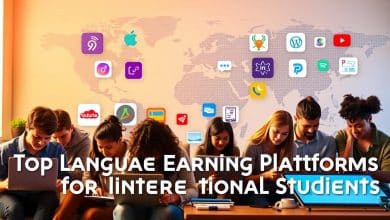How to Access University Resources Remotely
Modern education demands flexibility. Schools nationwide now offer robust digital systems to support learning beyond campus walls. From virtual libraries to cloud-based portals, these tools help learners stay engaged wherever they study.
Many institutions provide round-the-clock availability of materials. The University of Cincinnati, for example, offers over 4 million digital items through its online catalog. Commonwealth University’s single-entry portal simplifies connections to academic platforms for faculty and learners alike.
This guide explores practical ways to navigate these systems effectively. It covers authentication processes, security measures, and technical setups needed for seamless connections. Real-world examples highlight how major schools structure their digital services.
Remote capabilities aren’t just convenient—they’re vital for diverse learning needs. Whether managing schedules or overcoming geographical barriers, students benefit from reliable online pathways. These solutions ensure academic progress continues uninterrupted.
By understanding available platforms and their features, learners can optimize their educational experience. This resource breaks down complex systems into actionable steps, empowering users to leverage digital tools confidently.
Introduction and Overview
The surge in remote learning reshapes how academic communities interact. Schools now design systems to support learners facing diverse challenges—from time constraints to physical limitations. These platforms enable collaboration across distances while maintaining academic rigor.
Understanding the Need for Remote Access
Educational institutions prioritize adaptable solutions. For example, Commonwealth University reviews disability accommodations individually, ensuring equal opportunities through tailored digital tools. Faculty members increasingly use virtual office hours and cloud-based research platforms to engage students effectively.
The Impact on Students, Faculty, and Researchers
Remote capabilities create ripple effects across academia:
- Students juggling jobs or caregiving roles attend lectures asynchronously
- Professors share real-time data analysis during virtual lab sessions
- Global research teams coordinate projects across time zones
The pandemic accelerated these changes. A 2022 study showed 78% of institutions expanded digital services post-COVID. Below highlights key shifts:
| Aspect | Traditional Model | Remote Model |
|---|---|---|
| Collaboration | In-person meetings | Cloud-based tools |
| Resource Availability | Limited library hours | 24/7 digital archives |
| Flexibility | Fixed schedules | On-demand content |
These changes help learners overcome geographical barriers while fostering inclusive environments. As one administrator noted: “Our goal is removing obstacles, not lowering standards.”
Digital Tools for Remote Access
Technology bridges the gap between campuses and home offices. Institutions deploy specialized platforms to maintain academic workflows beyond physical locations. These solutions empower users to connect, create, and collaborate from any device.
Centralized Portals and Secure Networks
Single-entry platforms simplify connections to academic systems. Commonwealth University’s portal integrates course materials, grades, and research databases through one dashboard. VPNs add security layers for sensitive tasks like accessing financial records or proprietary software.
Cloud-Based Workspaces
Virtual desktops let users operate lab computers remotely. A biology student can run data-heavy simulations through VDI without expensive hardware. Teams like Microsoft Teams enable instant messaging, video calls, and shared document editing across departments.
Productivity Suites On Demand
Web-based email systems sync with Office 365 and Google Workspace. Faculty draft research papers in Adobe Creative Cloud during commutes. The technology help desk troubleshoots login issues through live chat or video guides.
These systems work best when combined. A professor might use VPN to grade assignments, then switch to Teams for student consultations. “Our tools remove location limits without compromising quality,” notes a Commonwealth IT director.
How to Access University Resources
Navigating digital platforms efficiently unlocks academic potential beyond campus boundaries. Commonwealth University’s CU Experience portal streamlines connections to essential systems, from course registration to research databases. This section outlines practical methods to maximize these tools while avoiding technical hurdles.
Step-by-Step Login Procedures for Digital Libraries
Begin by entering your institutional credentials on the library’s homepage. Most systems redirect users to discipline-specific databases after authentication. For example, JSTOR or ProQuest might require secondary logins for licensed journals. Follow these steps:
- Select databases matching your research topic using built-in filters
- Apply date ranges or peer-review filters to narrow results
- Save citations directly to cloud storage for later access
Brightspace learners often find course readings pre-loaded under weekly modules. Instructors may add publisher content through embedded links that auto-authenticate.
Using Tools like Microsoft 365, Zoom, and Virtual Systems
Microsoft 365 enables real-time collaboration through shared Word docs or Excel sheets. Students co-author group projects while professors leave feedback via comments. Zoom meetings thrive when participants:
- Test microphones and cameras before sessions
- Use virtual backgrounds to maintain privacy
- Record lectures for later review
Banner Self-Service simplifies administrative tasks through mobile-friendly dashboards. Check financial aid status between classes or submit graduation paperwork during commutes. Technical hiccups? Clear browser cookies or update Java plugins for smoother virtual system performance.
| Platform | Key Feature | Best For |
|---|---|---|
| Microsoft Teams | Document co-editing | Group projects |
| Zoom | Breakout rooms | Study sessions |
| Brightspace | Assignment tracking | Deadline management |
Leveraging On-Campus and Virtual Library Resources
Academic success increasingly depends on hybrid learning ecosystems. Institutions like the University of Cincinnati blend physical archives with digital repositories, creating flexible pathways for scholarly work. This dual approach supports everything from medieval manuscript studies to AI-driven data analysis.
Exploring Special Collections and Research Databases
Specialized libraries house treasures like first-edition novels and presidential correspondence. The Walter C. Langsam Library preserves rare materials while offering digital scans for remote review. Key platforms include:
| Database | Specialization | Sample Content |
|---|---|---|
| JSTOR | Humanities | Historical journals |
| PubMed | Medical research | Clinical trial data |
| Web of Science | STEM fields | Patent records |
Subject librarians create guides to navigate these tools. “Our role is connecting scholars with materials, whether they’re across campus or continents,” explains a Cincinnati collections manager.
Balancing Physical Library Hours and 24/7 Online Access
Minnesota’s Wilson Library operates 8 a.m.–8 p.m., while digital archives never close. Students in different time zones download journal articles at midnight. Those needing physical materials can:
- Reserve study rooms online
- Request book deliveries between campuses
- Schedule rare material viewings
Interlibrary loans bridge gaps when local collections lack items. Cloud-based systems let researchers save citations directly to reference managers like Zotero. This balance ensures continuous progress regardless of location or schedule.
Tips for Remote Research and Learning Effectively
Remote learners need smart systems to stay organized. Tools like assignment calculators and virtual workspaces streamline academic workflows. Institutions like the University of Minnesota offer workshops and research guides to simplify complex tasks.
Maximizing Productivity with Search and Content Tools
Effective search strategies save hours of work. Boolean operators and filters refine results across platforms. This table shows top tools for different needs:
| Tool | Key Feature | Best For |
|---|---|---|
| Academic Search Premier | Multi-topic coverage | General research |
| Google Scholar | Citation tracking | Broad literature reviews |
| Subject Databases | Specialized content | Discipline-specific studies |
Assignment calculators break projects into weekly steps. Students input due dates to receive personalized timelines. This prevents last-minute rushes during remote semesters.
Subject guides curated by librarians point researchers to credible sources. A psychology student might get directed to PsycINFO, while engineering majors find IEEE Xplore highlighted. “These guides cut search time by 40%,” notes a Minnesota library specialist.
Virtual study spaces mimic campus environments. Video-enabled group rooms allow real-time collaboration. Solo learners use focus timers and ambient noise generators to maintain concentration.
Faculty consultations address advanced research challenges. Professors demonstrate citation management software or explain niche database search techniques. Regular workshops teach skills like data visualization through live demos.
Conclusion
Digital innovation reshapes academic landscapes, blending traditional methods with cutting-edge solutions. Institutions now deliver education through hybrid ecosystems where physical classrooms merge with virtual labs. These systems empower learners in health sciences to practice telemedicine simulations while analyzing real patient data remotely.
Faculty development programs prioritize tech fluency, equipping educators with tools for dynamic online instruction. Regular training sessions cover interactive lesson design and digital assessment strategies. This ensures teaching quality matches in-person standards across programs.
Behind the scenes, continuous upgrades to platforms enhance user experiences. Intuitive interfaces and AI-driven search tools help locate materials faster. Support teams offer real-time guidance through chat systems, troubleshooting issues from login errors to research queries.
Looking ahead, expect smarter systems that adapt to individual learning patterns. Enhanced security protocols will protect sensitive data without hindering workflow. These advancements promise to make remote education more personalized and impactful for global academic communities.
FAQ
What tools are required to retrieve materials from the library remotely?
Can faculty and students use research databases off-campus?
How do virtual systems support remote learning?
Are physical library spaces still available for in-person visits?
What strategies improve productivity during remote research?
Can specialized collections be viewed online?
Published on: 18 de August de 2025







